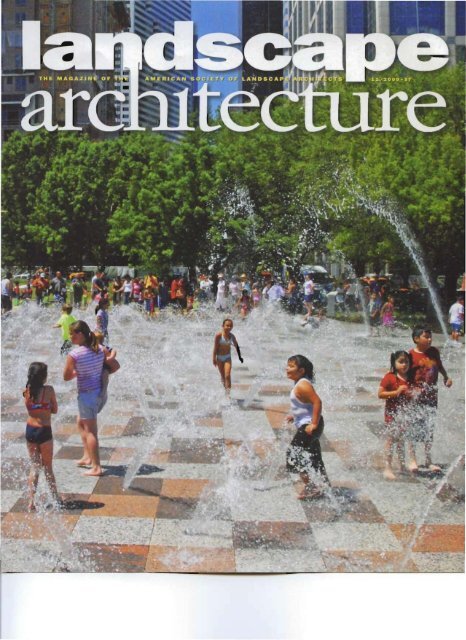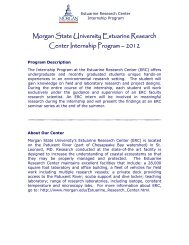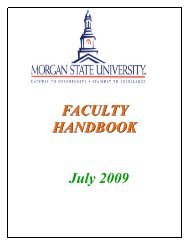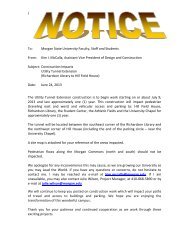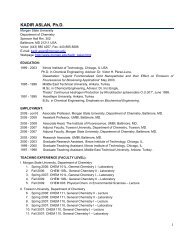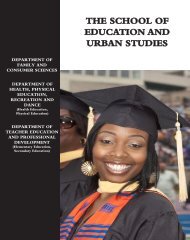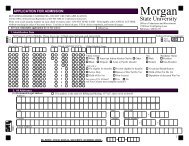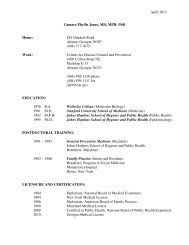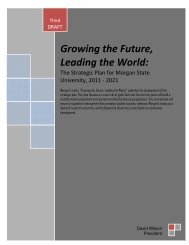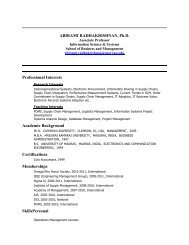Landscape Architecture - Morgan State University
Landscape Architecture - Morgan State University
Landscape Architecture - Morgan State University
- No tags were found...
You also want an ePaper? Increase the reach of your titles
YUMPU automatically turns print PDFs into web optimized ePapers that Google loves.
, I ATTENDED theited[LandsGlpe Architecrure,oDepartment] chair'smeeting at the PhiladelphiaASLA conference," 'WHENrecalls Glenn Smith, ASLA, "I wasamazed but not surprised that I wasstill the only African American in:,I ~ I'll) rIAhistorically black universitythe room after 30 years in the busi gr h aness." As the chair of the Departmentof <strong>Landscape</strong> <strong>Architecture</strong> at<strong>Morgan</strong> <strong>State</strong> <strong>University</strong> (MSU), Smirhfound a self-fulfilling prophecy. If minoriryundergraduate students don't have minorityprofessionals as role models and reachers,they are less likely to seek advanced degreesin landscape archirecture and become facultythemselves one day.Since rheir founding in rhe 19th century,America's historically black colleges anduniversities (HBCUs) have proved to be oneofthe greatest engines for bringing minoritystudents into a range ofprofessions andbreaking this cycle of exclusion. Indeed,<strong>Morgan</strong> <strong>State</strong>'s small MLA program offersits 35 to 40 students minority role modelswith two tenure-track and four adjunctdegrees (see Resources). <strong>Morgan</strong>, "<strong>State</strong> enrolls more than 6,000 studentson its hilltop campus in BaltiCOllilects urban ecologymore, ofwhich roughly a third comeand social justice.from outside Maryland. Yet the surprising£1.ct is that the majority ofBy Frank dge on a n <strong>Morgan</strong>'s graduate MLA studentsare white. Why is this the case atan HBCU located in the heart of amajority-black city? Equally puzzlingis the fact that <strong>Morgan</strong> <strong>State</strong>'sAfrican American faculty. Yet the professionsister graduate programs in architecrure andstill has a long way to go, not only in planning both have student bodies that inreaching out to African Americans bur to clude many African-born foreign srudentsthe entire range of people of color who and African Americans.make up the American mosaic. There are The white, middle-class characrer of therelatively few African American landscape next generation of landscape architects isarchitects working today even though evident in the MLA programs even at "diverse"rhree HBCUs-<strong>Morgan</strong> <strong>State</strong> <strong>University</strong>,universities such as Cal Poly PomonaFlorida A&M <strong>University</strong>, and North Carolinaand City College in New York-both covA&T <strong>State</strong> <strong>University</strong>-Dffer accred- ered in past <strong>Landscape</strong> Anhitectttre campusprofiles (see Resources). What does this discrepancyHoused in a large historically blackin graduate-level srudents even atuniversity in the middle of Baltimore, an HBCU like <strong>Morgan</strong> <strong>State</strong> say about landscape<strong>Morgan</strong> <strong>State</strong>'s MLA program offersarchitecture, its image for minoritystudents a remarkably 'high level of students, and the profession's perceivedpersonal contact with faculty and adjuncts. relevance for urban communities? These40 ILtadsupa Arc Ited r. DECEMBER Z009
On a rooftop overlooking the campus with its new library at the center, the landscape architecture faculty gathers for a group shot.From left are Jack Leonard, adjunct professor; Garry Meus, adjunct professor; Glenn Smith, ASLA, assistant professor and department chair;Diane Jones, ASLA, assistant professor; and Paul Voos, ASLA, assistant professor.questions mattet fOt the profession because,as Mary-Anne Ackers, <strong>Morgan</strong> <strong>State</strong>'s deanofarchitecmreand planning, writes, "HBCUfaculty introduce students to a sundry ofperspectives, cultural values, and ideas thatstudents in mainstream institutions missout on. Considering that minorities willconstitute 90 percent of the U.S. populationgrowth in the next 50 years, HBCUgraduates will be better equipped andready to address the needs of this heterogeneouspopulace."Having lived in Baltimore last winterand spent many afternoons with <strong>Morgan</strong><strong>State</strong>'s faculty and students, I kept hearingthat landscape architecture will becomemore diverse as a profession when its approachesto "susrainability," "beauty," and"community" make sense for the realitiesof minority and neglected groups. Whatdistinguishes <strong>Morgan</strong> <strong>State</strong>'s recently reaccreditedMLA program from those at manyother institutions is its focus on findingsuch relevance in the link between urbansustainability and environmental justice.This graduate program achieves a directkind oflearning by immersing students inthe urban landscape of one of the nation'smost historically rich, diverse, and (perhapsas the setting of many TV crimeshows) misunderstood cities.One MLA student told me that shethinks of<strong>Morgan</strong> <strong>State</strong> as urban more thanas black. That goes for both the curriculumand the location. <strong>Morgan</strong> <strong>State</strong> is locatedon one of the city's high points and is adjacentto its historic waterworks. Ifyou stand~loro'an <strong>State</strong> l niversity~ .<strong>Landscape</strong> <strong>Architecture</strong>DepartInentSchool of <strong>Architecture</strong>and PlanningLoea Ion: Betltimoretudent . 35-40Full- eu po tio : 3Degree offered: MLAceredIt : 1MW b : U'll'lt•.ra/J-l11rIrgdt].mmLCon the campus rooftops, you can see Baltimore'sworking harbor and much of thecity with its fascinating designed and naturallandscapes. Baltimore is home toRoland Park, one of the Olmsted office'smost sophisticated neighborhood plans,along with one of the nation's best parkwaysystems. <strong>Morgan</strong> <strong>State</strong> students live ina landscape where, as the students themselvespointed out to me, you can actuallysee the "falliine"-the point where the topographydrops sharply down to theocean-expressed in waterfalls and fastrapids in pans of the city. Besides the longestablishedtourist destination of the InnerHarbor, students can study and learn fromnumerous other hisroric sites such as theJones Creek corridor lined with historicmills and ravine ecology. They are also justan hour away from Annapolis, Maryland,and Washington, D.C., two ofthe nation'smost formally planned cities.Like Baltimore itself, MSU has notablediversity. Faculty and students point ourthe growing number of foreign studentsand an age range from mid-20s to mid-60sacross the MLA program. A handful of the421 Land capt Arcllltecture DECEMBER 2009
CAPUS PROFILEcurrent MLA students have global backgroundsfrom Asia and the Americas. Onegraduate student is a native of Barbadosand took his undergraduate education inCanada. Second-year MLA student A. ZeviThomas, Student ASLA, is African in descent,raised in the former Panama CanalZone, and speaks Spanish. After attendingPanama Canal College, where he studiedliberal arts with a concentrarion in art historyand anthropology, he moved to NorthCarolina for several years. "The emphasishere at <strong>Morgan</strong>," he explains, "seeks to addressurban issues which include the particularsof multicultural urban centers. Withmy background in cultural studies this focustruly appeals to me."Thomas was also attracted by the fuct thatMSU offers planning, architecture, and landscapearchitecture all w1der one roof in thesame school. <strong>Morgan</strong>'s history as an HBCUproved to be a relatively minor factor in hischoice of programs. He was, however, intriguedby the prospect. "After attendinghistorically 'white' colleges and universities,"he says, "I welcomed this opportunitywholeheartedly. The title HBCU oftenconceals the extensive diversity on campus;in the past year I have come in contact withso many nationalities here at <strong>Morgan</strong>."r.r.\Ve want students tolmderstand that thepoor want the samethinD'S as the richbrelative to healthy andclean environments,"says Snlith.Smith acknowledges thar global reach."Even as an Mrican American," be says,"it is difficult not to cast a broader diversitynet that includes race and gender."But he goes on to say that it is importantto respect the history that created theHBCU system. "In m,my ways HBCUs arestill necessary as America continues tostruggle with a viable conversation onrace." Perhaps the biggest misconceptionabout <strong>Morgan</strong> <strong>State</strong>'s students-andAfrican Americans in general-is thatthey are what Smith calls "a monolithicgroup of people."This vision of"blackness" and "diversity"is far broader than manyAmericans assume. And, it pointsto one way tbat MSU can use itsbase in a highly diverse city andregion to diversify the next generationof landscape architects.But recruitment must starr athome, on campus, with the studentsnext door. With roughly300 minority undergraduates in<strong>Morgan</strong> <strong>State</strong>'s architecture andThe students present their urbanorientedprojects with media embracingmany scales, top. The MLAprogram encourages urban environmentalanalysis through multiplelenses including hydrology, vegetation,urban history, and social justice.Glenn Smith, left, brings years ofexperience in both teaching andpractice to studio reviews.44llJlnd1icape Arc itecturDECUlBn ZDU
environmental design bachelor's degreeprogram, it seems there would be a naturalrecruitment pool. The programs arehoused in the same school within the<strong>Morgan</strong> <strong>State</strong> structure, and even thesame building. Yet, the IvD..A program hasattracted only one or two new students ayear from the university's undergraduatedesign program.One basic challenge is that virtuallynone of the undergraduate School of Planningand <strong>Architecture</strong> faculty are landscapearchitects. Many undergrads get theimpression that they do not need a landscapearchitecture degree to pursue theirpassion for site planning and design. Anotherchallenge is rhat they have few t'1.cultyand visiting studio critics who knowmuch about landscape histoty. One opportunityis <strong>Morgan</strong>'s location and prestigeamong the HBCUs. Christen O. Glascoecame to the J'.{lA program with an undergraduatedegree in sports managementfrom another Balrimore institution, Coppin<strong>State</strong> <strong>University</strong>. "I knew of <strong>Morgan</strong>'sreputation in the HBCU world mostly becauseI previously went to an HBCU," shesays. For her, the MiA program is the perfectdesign and ecological complement toher study of spons programming. To"build an efficient park," she explains, "oneneeds to know all the pieces and parts thatit needs." Across the countty, HBCUs withundergraduate programs in sports, ecology,and horticulture could provide a continuingpool of applicants like Glascoewho wish to round Out their skills.Another recruitment opportunity is wpromote the MLA program's unique focuson holistic urban ecology-and the landscapearchitecture faculty is starring to emphasizethis focus to undergraduates campuswidethrough lectures and a newannual "<strong>Landscape</strong> <strong>Architecture</strong> MonthForum" each April. Whereas, several yearsago, students took courses in "Plants andthe City," Smith has redirected rhe MiAcurriculum toward a much more integratedapproach to urban soil, water, andmovement systems. Today, students take asequence of courses in "Urban EnvironmentalResources" with case study explorationsofthe webs ofci ty hydrology, soils,utilities, and plant and animal life. Movingbeyond the horticultural model ofplanting and ornamenting theThese candid shots convey the informality and workshop ap city landscape, students areproach of the design reviews. Assistant Professor Diane Jones, learning how to interpret itsabove, gives feedback about a student's analysis drawing. ecological degradation and itsStudents update their drawings and text, belowand bottom, power to recover.as comments from their faculty and peers foster new ideas. MSU students learn that urbanlandscape architecture isnot so much "high design" for-plazas and grand parks butrather the most effective reknittingof the urban fabric comesfrom such less-glamorous effortsas neighborhood engagementand collaborative "visioning"for long-term local goals.<strong>Morgan</strong> <strong>State</strong>'s students learnthrough site visits and projectshow city ecologies respondto human interventions461lJ1 dS(:8P .rchlteclure DECEMBER 2009
such as creating hard surfaces along astream or the heat island effects of buildings.When they graduate, they have thegraphic and verbal skills to communicatethese ideas to neighborhood groups. It isnor surprising, given the program's longstandingfocus on public service, that manyalumni currently work in public agenciesin the Mid-Atlantic region.The MSU ethos also means understandinghow planning decisions affect a fullrange ofpeople. "Because we work withininner Baltimore City neighborhoods ofcolor, the issue ofenvironmental justice expandsthe definition of sustainability,"Smith says. "We want students to understandthat the poor want the same thingsas the rich relative to healthy and clean environments,"he adds. Community-basedplanning and design projects are a majortool for this effort and one of the MLA program'sgreat strengths.DianeJones, ASLA, who came ro MSU asan assistant professor in 2006, leads theprogram's evolving discussion on environmentalaccess and equity. "I lived andworked in New Orleans for 18 years andhad my own practice there for 1l, so myteaching is very much shaped by that experience,"she says. "Baltimore is very similarto New Orleans in interesting ways ...both old cities, located on water, with verystrong cultures. I always teU people, if Katrinahad hit Balrimore, it would have beenvery much the same...a lot of people dependon mass transit here and would havebeen unable to get out."In OctOber 2009 she took her Studio Vclass (an urban design workshop) to NewOrleans to work on a joint project with S[Udentsfrom the MLA program at Louisiana<strong>State</strong> <strong>University</strong>. They worked on designconcepts for Claiborne Avenue, where theconstruction of Interstate 10 divided thehistoric Treme community. Students collaboratedwith community aod governmentleaders to envision the corridor withourthe intrusive interstare. Before the trip,Jones said she hoped her students wouldget the chance to explore how landscape architectscan really shape social and environmentalequiry.Closer to home, Jones asks students to"look beyond form and function" to explorehow design decisions affect "accessibility,equity, and environment." For example, sheCIRCLE 95 ON READER SERVICE CARD OR GO TO HTTP://INFO.HOTIMS.C0M/23500-95ERltA SOCIBY OF lANDSCAPE ARCHITECTS36 Esm W. WASHIHTO DC 20001-3135202-898-2444 •FAX 202-89.2285 WWWlSI181GDECEMBER 2009 land eape Arehllec.turel 47
CAMPUS PROFILEis working with students in preservationplanning for Mt. Auburn,one ofthe most historically significantAfrican American cemeteriesin the Mid-Atlantic region. Shechallenges them to define "historicpreservation" and "sustainability"with f,1r broader socioeconomicimplications than normally examinedin landscape history and preservationpractice.With the school's focus on theBaltimore region and the socialecologicaloutlook ofurban sustainability,MSU students have thechance to apply design principlesagain and again at sites of manyscales and economic uses. The program'sthird full-time professor,Paul Voos, ASLA, graduated from <strong>Morgan</strong><strong>State</strong>'s MIA program himselfand essentiallygrew up in the profession surrounded byBaltimore's neighborhoods. Of the landscapearchitecture taught at MSU today, hesays, it's "not just about signature buildings,signature parks, and the grand boulevards;it's about the everyday fimctioning environment.Urban landscapes are the cwnulativeofthe special and the mundane." Kurt Culbertson,FASLA, who recently served on theMLA program's accreditation review team,affirms the f,'lculry's claims. "If someone isinterested in the social and economic transformationof urban communities throughdesign," he says of the MSU program,"there's probably no better venue."With Baltimore at their doorstep, theMLA students occasionally find their ownprojects to test out ideas. Jean Mellot,Student ASLA, a tbird-year student withcollege-age children and a natural sense ofleadership, recently organized a studentledcharrette to design a nature garden fora nearby elementary school. The idea, sheexplains, is for high school students fromthe nearby City College High School toteach environmental studies to the gradeschoolers in the garden.Several of the MLA students I met dutingthe weekend charrette for tbe gardenhave master's degrees and doctorates in otherfields including clinical and social psyBecause many of the students have already held post·college jobs and careers, they areeager to learn practical applications that complement their emerging academic knowledge.Thus, they enthusiastically attend field trips to materials suppliers and organize volunteercho'logy. Two work as administrators atJohns Hopkins Universiry. They come fromother careers and years of Life experience andresearch in other disciplines. For this reason,most ofthe students are hlUlgry to learnabout the tactile and practical applicationof landscape archi tecture. "All oflIS get fascinatedby the technical part of design,"Mellot says. "Every time there is a field tripto go see a concrete plant or something, wea11 go," even ifit's nor required. "We knowthe difference berween kinds ofconcrete finishtechnically, but not hands on."design projects for Baltimore schools and charities."Historically, the programhas attracted priInarilynlature, "nontraditional'students," who sharestudios with dle handfulof students who enrolledjust out of college.Lo11y Tai, FASLA, also part of the recentaccreditation team, says that the students'age range is one of MSU's unique traits."Historically, the program has attracted primarilymature, 'nontraditional' students,"she notes, who share studios with the handfulofstudents who enroLled just Out ofcollege.This can be both good and bad. I noticedthat many of the younger studentsbecome like younger siblings to tbeir peerswho organize field trips, tell stories, talkpolitics in Baltimore, and prize being in nature.These relationships are something thatcannot be programmed in the curricula.The downside, as some of the faculty pointout, is thar the older students can inadvertently"smother" the creativity of theiryounger classmates who may try to mimicthem. For this reason, they encourage all ofthe students to develop their own ideas andgraphic styles. "This is a time to explore,"says Smith, "not always to be mentored."This year's accreditation process pointedout several challenges the MSU programneeds to overcome. Facilities ate poor, withan aging 1950s building, outdated ventilation,and minimal lounge and gallery space.In addition, there's a lack of computer481 <strong>Landscape</strong> r It dura D£CIMDU 2001
CAMPUS PROFILEsupport staffing, although it's likely thatthis problem will be addressed soon. Theaccreditation team also noted that the programshould develop an on-campus collectionof books, periodicals, and other resourceswithin the MSU Library.Having graduated its first class in 1982,the program is relatively young, and thathelps to explain this lack of accmed collectionsand the relatively untapped alumninetwork. In the coming years, Smithwill be working increasingly with theMaryland ASLA chapter to secure studentinternships while building a strong departmentAlumni Advisory Committee tosupport "curriculum reviews, student internshipsand job placement, development(fund-raising), guest lectures, and studioreviews," as recommended by the accreditationteam.Smith is also working to improve theprogram's commitment to and recogni-Expanding the yield ofMS undergrads whocontinue on to an MLAis a top priority if theprogranl is to flourish.tion of research. He teaches a required researchmethods course, which teaches thebasic concepts of validity-measuringwhat you claim to be measuring-andreliability-making measurements inconsistent ways that yield repeatable results.Students use his course to test outthesis ideas and to learn how ro bringspecificity to their hypotheses and researchquestions for studies ranging from thereuse ofsuburban shopping malls to parkdesign along Baltimore's waterfront.Roberta McConochie's thesis on schoolyarddesign typifies how the MSU programhas grown more rigorous and focusedover the past three years. Havingspecialized for years in social scienceteaching and research at the universitylevel, McConochie, who already has aPhD in social science research, has alsoworked in the private sector in publicopinion surveys. Nearing traditional retirementage, but retaining the idealismof her Peace Corps stint in Iran during the1960s, she decided landscape architecturewas the best profession for working withurban education and the environment.Her thesis project will involve controlledcase studies ofselected urban schoolsites and their effects on children's awarenessof and care for nature. "The thingabout 'nature-deficit disorder,''' she argues,"is that we make it sound like it's a disorderon the kids' part, when really we're theones to blame." Her hypothesis is thatschools and adults in city neighborhoodscan redress this shortcoming through carefuldesign and programming of remnantopen spaces.Gary Kesler, EASLA, the chair of the accreditationreview team, told me that theGROWERS OF HIGH QUALITY DECIDUOUSTREES, SHRUBS, ROOTSTOCKS & SEEDLINGSwww.carltonplants.comCIRCLE 298 ON READER SERVICE CARD OR GO TO HTIP,lnNFO.HOTIMSCOMI23500-29850 Ilend.cepe <strong>Architecture</strong> DECEMBER 2D09
team was in agreement concerning the essentialrole of applied research skills in futurelandscape architectural education andpractice. Yet, no student or graduate programcan be strong in all research areas.Small programs such as <strong>Morgan</strong> <strong>State</strong> mustspecialize in a vision and approach for addressinga specific regional landscape, a recommendationexemplified by projecrs likeMcConochie's. For <strong>Morgan</strong> <strong>State</strong>, this meansthe urban region of Balrimore, the ecologyof the Chesapeake Bay watershed, and thediversiry of the people who live there.After much faClllry turnover during thepast 15 years, the MSU program is now themost stable it has ever been. As the threefull-time professors begin their fourth yeartogether, it's clear that expanding the yieldof MSU undergrads who continue on to anMlA (rather than going into architecture orplanning or another field) is a top priority ifthe program is to flourish. The landscapefaClllry is developing a transitional curriculumwhere undergraduate students in thebachelor ofscience in architecture and environmentaldesign program can, in Smith'swords, "fast forward ro the graduate programby taking their final design studiowithin the graduate program."The faculty members know they have along way to go to bring in more minoritystudents, but after stabilizing the longunderstaffedprogram and passing their secondfull accreditation, they are now able toexperiment. "The location [in the samebuilding as the undergraduate design program]is agift to our program,"Jones says. "Idon't think that this gift was very much appreciatedin the past, bur 1 think the newleadership we have in the department realizesnot only [the value] ofrecmitment right hereat <strong>Morgan</strong>, but what a contribution couldbe made to [reducing] the dearth ofAfricanAmerican landscape architects." Success onthat from could run the self-fulfillingprophecy in reverse, ensuring increased diversityin the profession at all levels: students,professors, and professionals.Frank Edgerton Martin is a landsCt:tpe bistwian,campus plamm·; and regula1' contributor to<strong>Landscape</strong> Architecrure. He hm lv1'itten pri01' cawpm pr~files on Cal Poly P01llona and tbeCity College ~fNeUJ }'(Jrk.R urcesFor other relevanr campus profiles in <strong>Landscape</strong><strong>Architecture</strong>, see:Cal Poly Pomona: "Educating for a Regionin Change," by Frank Edgerton Martin,July 2008.City College of New York: "Design forCities," by Frank Edgerton Martin, April2009.North Carolina A&T <strong>State</strong> <strong>University</strong>:"Recruiting Diversity," by Susan Hines,December 2006.For a useful description of the roles ofHBClJs in future design education, see:• "Addressing Design Disparities: TheRole of Historically Black Colleges andUniversities," by Mary Anne AlabanzaAkers; Design Intelligence, December 18,2007. Available online at www.di.netlartic!eJ/archive/addrming_design_disparities_role. (Akers is the dean of <strong>Morgan</strong> <strong>State</strong>'sSchool of <strong>Architecture</strong> and Planning inwhich the NfLA program is housed.)Petersen Mfg. Co., IncConcrete and MetalSite FurnishingsCIRCLE 158 ON READER SERVICE CARD OR GO TO HTIP:/i1NFO.HOTIMS.COMI23500-1 saCIRCLE 20 ON READER SERVICE CARD OR GO TO HTIP://INFO.HOTIMS.GOMI23500-20O£CEMIER 2009 LOIndsc pe Arc:llItec:tu .151


